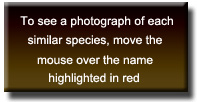
 |
|
|
Leucania incognita (Barnes and McDunnough)
Diagnosis:
Distribution (See maps below): Leucania incognita is primarily known from southern and central Texas, but the species has been collected from as far west and southern Arizona. In the east this species occurs in Florida. The species is also known to occur in Mexico, Central America, and the Antilles. Identification Quality: Excellent. However the two principal North American populations are significantly different in superficial appearance, although there are no significant differences between the male genitalia of the two populations. The relationship between these two populations must be sought in the tropical distribution of the species. Habitat: Leucania incognita is a tropical and subtropical species. No specific information about habitat is available. Foodplants: Unknown. Larval Description: None available.
|
Leucania incognita
Similar Species: This species is easily separated from all other North American species by its brown coloration with the dark streak through the center of the wing and the white hindwing with the small black dots along the outer margin. |
Similar Species No Similar Species |
 |
